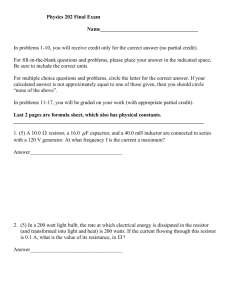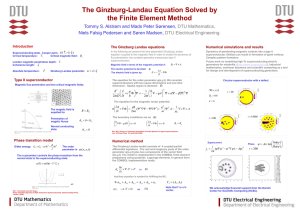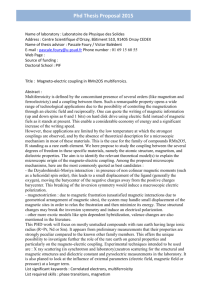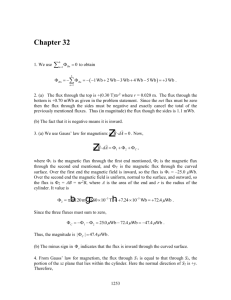notes13-- Interactions of electrons with an electromagnetic field
advertisement
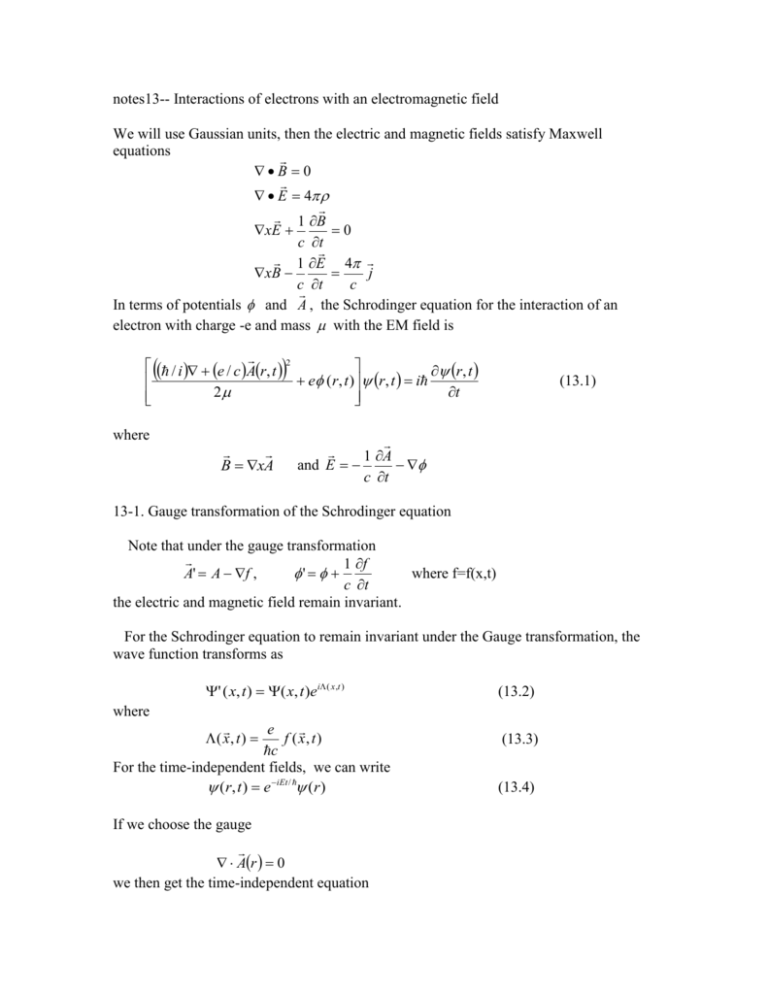
notes13-- Interactions of electrons with an electromagnetic field We will use Gaussian units, then the electric and magnetic fields satisfy Maxwell equations B 0 E 4 1 B x E 0 c t 1 E 4 x B j c t c In terms of potentials and A , the Schrodinger equation for the interaction of an electron with charge -e and mass with the EM field is / i e / c Ar, t 2 r, t e ( r, t ) r, t i 2 t where B xA (13.1) 1 A and E c t 13-1. Gauge transformation of the Schrodinger equation Note that under the gauge transformation 1 f ' A' A f , where f=f(x,t) c t the electric and magnetic field remain invariant. For the Schrodinger equation to remain invariant under the Gauge transformation, the wave function transforms as ' ( x, t ) ( x, t )ei ( x ,t ) (13.2) where e ( x, t ) f ( x, t ) c For the time-independent fields, we can write ( r, t ) e iEt / ( r ) If we choose the gauge Ar 0 we then get the time-independent equation (13.3) (13.4) 2 2 ie e2 A A2 e ( r ) E 2 2 c 2c (13.5) 13.2. Constant magnetic field For a constant magnetic field B, we can take 1 A r B 2 The Schrodinger equation takes the form (13.6) 2 2 ie e2 A A2 e ( r ) E 2 c 2c 2 Manipulating the 2nd term above, (13.7) ie ie r B B r 2c 2 c e e B r B L 2 c i 2 c (13.8) Manipulating the 3rd term, 2 e2 2 e2 e2 B 2 2 2 2 r B r B r B x y 2 (13.9) 2 2 2 8c 8c 8c We will note that for ordinary magnetic field (13.8) and (13.9) are quite small, and thus the two terms can be treated as perturbation. (13.8) is for the normal Zeeman effect, and (13.9) is for the quadratic Zeeman effect. For a free electron in a static magnetic field, the electron is confined by the potential given by (13.9). Note that this is a 2D harmonic potential, and the allowed energy levels are given by equal spacing according to the harmonic oscillator solutions. These levels are called Landau levels. Small B-field-- normal Zeeman effect If B-field is small, equation (13.7) is solved by the perturbation theory with H1 e 2 c BL z L Lz where L e 2 c B is the cyclotron frequency. If the unperturbed Hamiltonian has spherical symmetry, the eigenstates are given by unm such that the perturbation energy for such a state is given by E n1m L m This is called normal Zeeman effect. Note that in the current model, we have not included the spin of the electron. This will be done later. The perturbation H1 can be viewed as the interaction of a magnetic dipole due to the orbital motion of an electron in a magnetic field. The dipole moment is given by e e ML L g L L gL 2mc 2mc where we have used m for the mass of the particle. The second equality is to show the general relation between the magnetic dipole moment and angular momentum. In the present case, g L =1. The last equality shows that is an elementary unit of the magnetic dipole moment. The last expression can be generalized to any particle and the orbital angular momentum can be replaced by the spin. In that case, the g can take different values. Using M L , the interaction energy of such a magnetic dipole in a B field is given by e H1 M L B BL z 2mc If the B-field is along the z-direction. In the case of electron spin, the magnetic dipole moment is given by e MS gS S 2mc where ... ) is the g-factor for the electron, taken to be 2 for most of our 2 purpose. It is a fundamental property of an electron and its value can be calculated using quantum electrodyamics (QED). g S =2 (1+ 13.3. Flux Quantization and the Aharanov-Bohm effect The gauge invariance of the electromagnetic fields has a number of important real physical consequences. We talk about two here. The other important one is the quantum Hall effect which is a little bit more complicated. (a) Flux quantization From (13.1), the time-independent equation is 1 e ( A( r )) 2 ( r ) V ( r )( r ) E( r ) 2 i c This equation can be solved by writing ( r ) 0 ( r )e i ( e / c ) f ( r ) where (13.10) (13.11) 1 2 ( ) 0 ( r ) V ( r )0 ( r ) E0 ( r ) 2 i and r f ( r ) dr ' A( r ' ) P The line integrals along two different paths would have the difference r d r ' A(r ' ) - d r ' A ( r ' ) ' x A ( r ' ) d S B = d r ' A ( r ' ) dS 1 2 r S This if the line integral encloses an area where the magnetic flux is zero, f (r ) obtained from the two paths are identical. If the magnetic field is not identically zero, then for the wavefunction to be single-valued, the phase factor from the two different paths should be equal to 2n , or e 2 n c and 2c n, n 0,1,2,... e (13.12) This is the magnetic flux quantization-- a direct consequence of Gauge invariant. Example: Consider a magnet having the shape of a donut. At normal temperature the magnet is a normal metal and the magnetic flux lines can penetrate the hole as well as the metal. At low temperature where the metal becomes a superconductor. For the superconductor, the so-called Meissner effect says that the magnetic field lines cannot penetrate the superconductor, i.e., B=0 inside the superconductor. The flux quantization rule says that the total magnetic flux penetrating inside the hole should be governed by eq. (13.12). Actual experiment shows that the electronic charge e should be replaced by 2e. The reason is that the charge carrier in a superconductor is a Cooper pair-- two electrons with momentum p and p coupled together to form an elementary unit. Aharanov-Bohm effect: Schematically, electrons following the two paths shown in the diagram will have interference fringes depending on the total magnetic flux enclosed. The additional phase e , in addition to the phase from the path difference. By difference is given by c changing the magnetic field the interference fringe will differ. Homework 13 13.1. Let us estimate if the 2nd term in (13.7) can indeed be treated as perturbations. Consider the 2p state of atomic hydrogen (neglect spin). Estimate the ratio of the energy from the second term with respect to the 2p state energy for a magnetic field strength of 100 Gauss. Be careful that we are using the Gaussian units here so make sure you have the B-field in that units. 13.2. A particle of mass M is attached to a rigid massless rod of length R whose other end is fixed at the origin. The rod is fixed to rotate about its fixed point. (a) Show that the Hamiltonian is given by L2 1 2 H ( Rxp ) 2I 2I where I=MR2. (b) If the particle carries charge q, and the rotor is placed in a constant magnetic field B along the z-direction, what is the modified Hamiltonian? (Follow the example in this chapter) (c) For small B, what is the energy spectrum?




